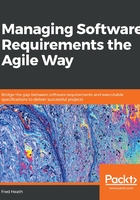
What this book covers
Chapter 1, The Requirements Domain, helps you understand the requirements domain and the difference between requirements and specifications, and introduces you to goals and stakeholders, two of the four requirements domain entities.
Chapter 2, Impact Mapping and Behavior-Driven Development, expands our knowledge of the requirements domain by defining and explaining capabilities and features. It then helps us learn how to model our requirement entities using impact maps. Finally, this chapter helps us to explore BDD and see how it complements impact mapping to provide a comprehensive requirements analysis approach.
Chapter 3, Writing Fantastic Features with the Gherkin Language, details how to define system behaviors as feature scenarios using the Gherkin language. It provides tips and techniques that will allow you to take full advantage of the expressiveness of Gherkin. It also explains how features can be leveraged as executable specifications.
Chapter 4, Crafting Features Using Principles and Patterns, offers techniques, patterns, and thought processes that will enable you to write durable and well-scoped features. It also shows you common mistakes that should be avoided.
Chapter 5, Discovering and Analyzing Requirements, teaches you three different techniques for capturing and analyzing requirements from stakeholders.
Chapter 6, Organizing Requirements, tells you what you need to do to provide transparency and traceability to stakeholders and how to get ready in order to start delivering requirements as part of an agile development cycle.
Chapter 7, Feature-First Development, illustrates how to turn features into code, using a software development process that can be applied within the Scrum framework or the Kanban method.
Chapter 8, Creating Automated Verification Code, shows you how to write solid verification code using specific design patterns.
Chapter 9, The Requirements Life Cycle, starts by outlining the techniques and methods learned in this book within the context of the canonical requirements management life cycle. Finally, it summarizes the requirements management workflow exhibited in this book.
Chapter 10, Use Case: The Camford University Paper Publishing System, recreates the beginning of a typical requirements analysis and modeling workflow using a fictional project. It also provides some tips and advice for project and client management.